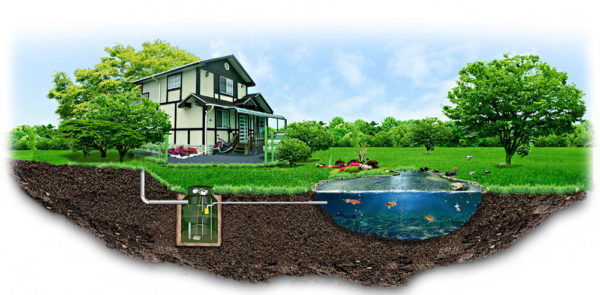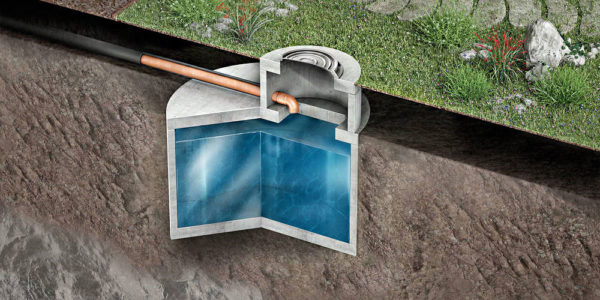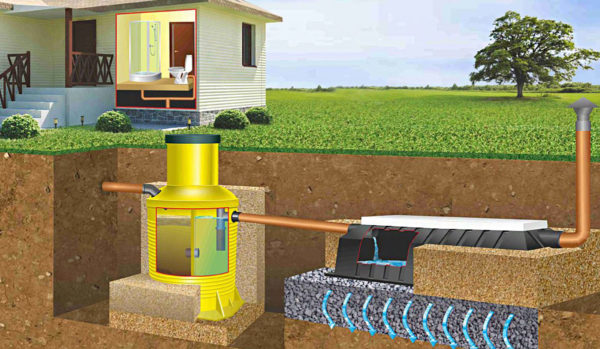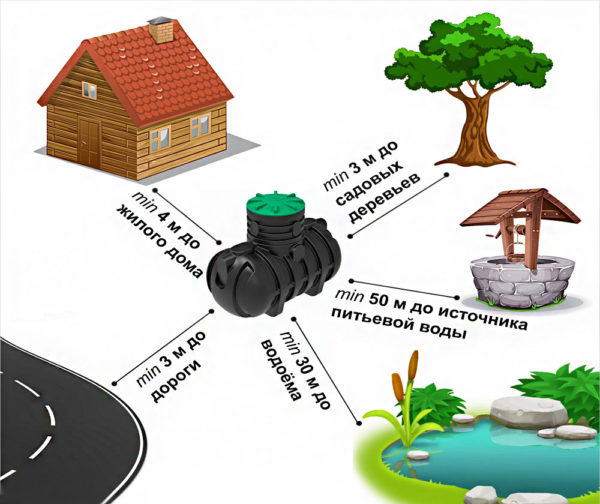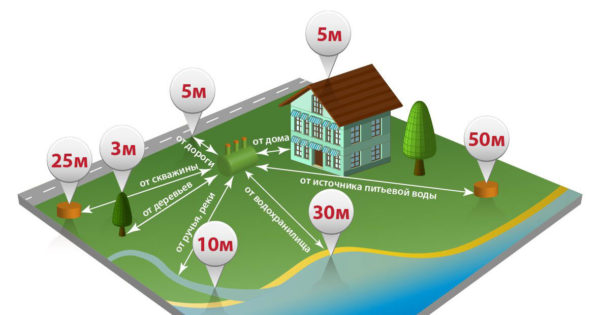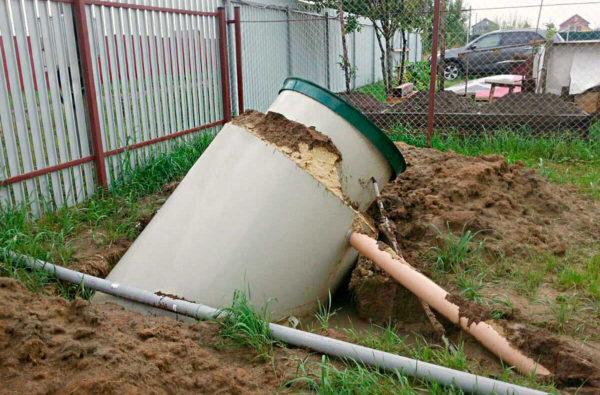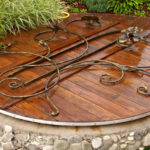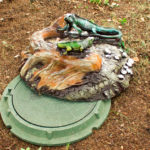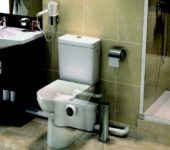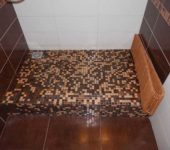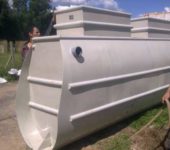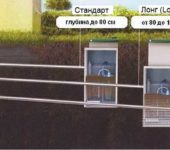How to place a septic tank on a site in compliance with SNiP and SanPiN
The norms for installing a septic tank on the site are the most important detail that the developer must study. Supervisory organizations closely monitor compliance with all prescribed regulations and have the right to issue administrative fines for their violation.
The content of the article
- 1 What is a septic tank
- 2 How to position a septic tank on the site
- 3 Distance to the well, well
- 4 Distance to the water supply
- 5 Distance to the house, neighboring plot and fence
- 6 Distance to the garden, vegetable garden
- 7 Other installation requirements
- 8 Factors affecting placement
- 9 Standards for SNT and IZHS sections
- 10 How to decorate a septic tank
- 11 Outcome
What is a septic tank
A septic tank is a storage tank for sewage, installed in a suburban area, where there is no possibility of connecting to the central sewage system. Often it is made in the form of a plastic container located underground.
The structure can be equipped with several chambers for mechanical and biological treatment, through which household waste flows in sequence. Discharge of treated water is allowed to the terrain or into water bodies, subject to disinfection and fine filtration.
The advantages of installing a septic tank
In summer cottages located at a distance from centralized sewage systems, a septic tank has a number of undeniable advantages:
- ease of installation and ease of use;
- lack of unpleasant odor;
- environmental safety when installing sealed devices;
- high degree of wastewater treatment - up to 98% when using biological stations.
The difference between a septic tank and cesspools
Many homeowners choose one of the easiest ways to collect waste water using cesspools. The pit can be a pit, concreted around the perimeter. The volume is determined approximately by the amount of wastewater, as well as the people living in the house. This method does not require significant costs, but in the future it can lead to many problems:
- waste from the house is not recycled, but goes directly into the soil and contaminates it;
- periodic call of the sewer truck for cleaning;
- a hole must be dug at a certain distance from a well with drinking water;
- fragility of the structure;
- inability to cope with large flows.
How to position a septic tank on the site
Before starting construction, you should familiarize yourself with the rules for its placement. The installation must take place taking into account several regulatory documents, namely:
- SNiP (Building Norms and Regulations) 2.04.03–85 Sewerage. External networks and facilities.
- SanPiN 2.2.1./2.1.1.1200-03 Sanitary protection zones and sanitary classification of enterprises, structures and other facilities.
- SNiP 2.04.01-85 "Internal water supply and sewerage of buildings".
- SanPiN 2.1.5.980-00 "On the sanitary well-being of the population."
On the territory of the country, uncontrolled construction of treatment facilities is prohibited. The project of the future structure must be approved by the SES.
Important! After receiving approval from the SES, the installation must be carried out in accordance with the approved project. The likelihood of control checks by the service is high.
First of all, it is worth understanding the question: when is the best time to install a septic tank. The ideal season for installation is considered to be summer and autumn. Groundwater, rising to a minimum level, does not interfere with the process. Of course, in winter, the demand for the station is not so high and it becomes possible to get a good discount, but the frozen soil and uncomfortable working conditions will require additional costs.
Distance to the well, well
Some of the most demanding regulations concern the distance from the septic tank to the water intake point. Such a serious emphasis on this point of the rules comes from the fact that the ingress of effluents into the ground is fraught with water pollution and subsequent poisoning.
The correct location is considered to be a distance of 30 or more meters from a well or well. Moreover, the water intake point should be higher in the direction of the groundwater flow. If sandy or loamy soil is more pronounced on the site, then the minimum permissible distance increases to 50 meters.
Distance to the water supply
The minimum distance from the septic tank to the central water supply should be 10 meters in order to avoid consequences in the event of an unforeseen accident.
Distance to the house, neighboring plot and fence
It is allowed to have a septic tank at least 5 meters from your own house. Experts also do not recommend removing the treatment plant at a distance of more than 20 meters from the housing, since in this case the probability of depressurization of a long pipeline increases.
When installing, it is worth remembering about the neighbors. The septic tank must maintain a distance of at least 2 meters from a neighboring fence, as well as 5 meters from a busy section of the road.
Distance to the garden, vegetable garden
It is not advisable to locate a leaky structure near trees and bushes. A distance of less than 5 meters will lead to the accumulation of excess moisture, which will lead to the death of plants.
Other installation requirements
Additional rules for installing a local sewage treatment plant take into account the necessary measures for optimal operation:
- if there are any buildings in the area of the site, it is required to provide a distance of at least 1 meter from the septic tank to prevent washing;
- the station requires periodic cleaning of silt;
- it is also necessary to retreat from the gas pipeline. At least 5 meters from it.
Factors affecting placement
In addition to the above, the distance from various objects, on the site it is worth paying attention to other equally important points:
- the type of septic tank chosen;
- determination of the depth of groundwater;
- form and method of installation;
- tilt level on the ground;
- the nature of the soil of the area.
Standards for SNT and IZHS sections
First of all, it is worth understanding the abbreviations and their meanings. IZHS - individual housing construction. The land on which the IZhS is located is located within the boundaries of the settlement and has the right to provide the necessary set of infrastructure from the authorities. SNT - garden non-profit partnership. This is an association of several sites for agricultural activities. Plots can be located only outside the territory of settlements.
Permanent residence in IZhS and seasonal stay in SNT require different regulations from SNiP and SanPiN. At the moment, installation norms do not depend on the status of ownership, but on the permanent or temporary type of residence and the number of people.
Important! The installation of a septic tank can only be carried out on a private territory. Placing a structure behind a fence is illegal.
How to decorate a septic tank
Treatment stations are divided into several types, but all have a hatch in the form of a square or round platform on the surface. Not everyone will be delighted with the appearance of such a structure. The appearance of the structure can be easily decorated and organically fit into the current landscape:
- Decorative cover for the manhole of the sewage treatment plant
- The hatch is easy to hide
If it is necessary to periodically pump out the container, of course, you should not limit the entrance and complicate pumping. However, you can sprinkle the structure with multi-colored pebbles, paint the lid or surround it with a lawn.
If the biological station does not need maintenance or it is very rarely carried out, then you can equip the site more colorfully. It can be some kind of stumps, figures of people and animals in the bushes. In general, there is a place to roam fantasy.
Outcome
Treatment facilities on a site where there is no possibility of a central sewerage system - the design is necessary. Even better is the installation of an autonomous station, which does not require frequent maintenance and carries out deep purification of wastewater, and is also operated for a long time.
It is worth remembering that the station must be installed strictly in accordance with all the rules and regulations of SanPiN and SNiP. Neglecting regulations entails economic sanctions.

